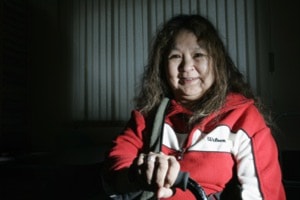After her first hyperbaric oxygen treatment at the Misericordia Hospital in Edmonton, Rhoda Noksana felt like running down the halls.
No sooner had she felt this exhilaration than she remembered that she had suffered a stroke and could not run.
Still, the beneficial effects of the treatment were instantaneous.
Noksana suffered a major stroke April 27, 2003.
She was first treated at Whitehorse General Hospital, but it soon became evident that she would need medical services that the hospital could not provide.
Noksana was flown to Edmonton within 24 hours of her stroke to have brain surgery to remove part of her skull to make way for swelling of her brain.
Noksana was 36-years-old at the time.
The skull fragment has since been reattached.
Although she still requires a brace, the leg that was paralyzed by her stroke, her left, no longer swings out when she walks.
She also feels a general improvement in her health. She suffers less nausea and experiences fewer headaches.
However, a big problem remains.
Hyperbaric oxygen treatment, a form of therapy where patients are placed in a chamber and subjected to high concentrations of oxygen in order to awaken disabled brain cells, isn’t covered by Yukon health care or First Nations non-insured health care.
Noksana cannot afford the 50 hours of treatment prescribed by her doctor.
At $100 a shot, Noksana would have to spend $5,000 to complete the 50 hours of oxygen therapy.
The closest hyperbaric oxygen treatment facility is at the Misericordia Hospital in Edmonton and Noksana estimates that it would cost her and her caregiver $11,389 for the 50 sessions of oxygen treatment when airfare and accommodation are factored in.
The treatment would require two 10-night stays in Edmonton.
According to Noksana, due to the immediate improvement of her symptoms, her doctor (Dr. Emil Bekhit at the Second Avenue Walk-In clinic) said that she would regain most of the function on the left side of her body with further treatments in the hyperbaric chamber.
According to Health Canada, hyperbaric oxygen therapy heals by delivering a high concentration of oxygen quickly and deeply into the affected areas of the body.
While hyperbaric therapy is certified by Health Canada for ailments such as thermal burns and carbon monoxide poisoning, other studies have been mixed.
The government warns that its benefits for cases of cerebral palsy, multiple sclerosis and stroke are not proven.
Even so, Noksana is completely convinced of the healing powers of the oxygen therapy.
Until Noksana receives further treatments in the chamber, she remains mobile only with the use of a leg brace and a cane.
She also relies on the help of her partner and teenage children to do the cooking and house cleaning and to clean and bathe her.
Before hearing of the hyperbaric oxygen treatment, Noksana was told she would have to learn to live with her disability.
“At no point in time did anybody, especially anybody here, suggest hyperbaric oxygen therapy would help Rhoda,” said her partner and interpreter, who chooses to remain anonymous.
“So anything she has accomplished hasn’t been with the help of the medical community here other than Dr. Bekhit recommending the therapy.”
Noksana’s partner spoke to somebody at Health and Social Services to see if Yukon health care would cover the cost of the hyperbaric treatments and was told that under no circumstances was that going to happen.
“And then we approached First Nation health and they basically laughed at us and said, ‘sorry about your luck, but it isn’t going to happen, we’re not going to cover it,’” said her partner.
Ultimately her partner ended up paying for five and a half hours of treatment himself.
“In the five and a half hours that I have done, I’ve noticed a change,” said Noksana.
“My complexion has changed, my walking has changed; I used to walk where my left leg would swing.”
The reason I would like to get the rest of this treatment done is to get my independence back, said Noksana.
“I’ve lost most of my independence,” she said.
“I used to work and I don’t anymore.
“I used to play baseball and I don’t do that anymore either.”
